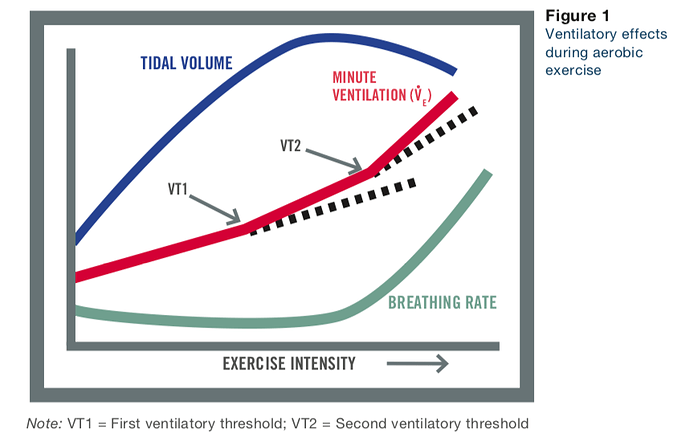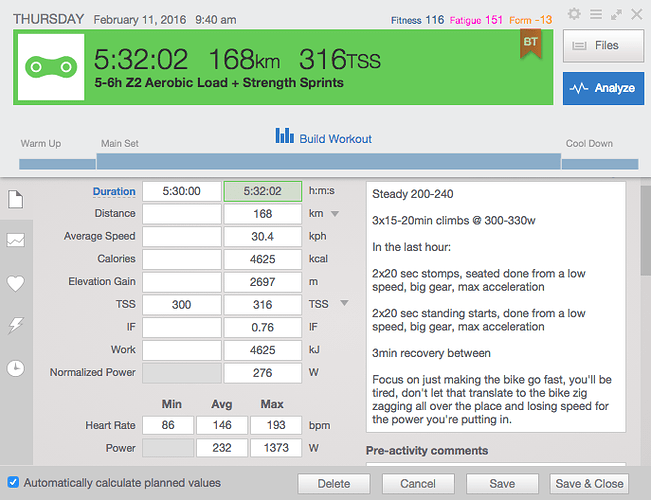Me too. I regularly do 3/4 hour group rides over to the coast and they tend to be quite a high intensity. Afterwards I’m very tired and my legs ache. I did the same ride with a friend who doesn’t ride quickly and so I ended up doing it exclusively below LT1. The ride took 5 hours and that night my legs didn’t ache in the same way but felt like they were on fire!
IIRC, the formula was as follows, right?
HR range = Max HR - morning / resting HR
VT1 = 0.65 * HR range + morning / resting HR
VT1 = 0.85 * HR range + morning / resting HR
So for me, I get:
HR range = 190 - 40 = 150
VT1 = 150 * 0.65 + 40 = 138
VT2 = 150 * 0.85 + 40 = 168
Is that what you had? I’ve also heard Seiler use VT2 as 88% - 90% of max HR, which for me would be 167 - 171, right in line with the other VT2 formula.
What points in the Ramp Test did you use for VT1 and VT2? For my last Ramp Test, the formula lines up with ~80% of FTP for VT1 and ~115% of FTP for VT2.
This could be one way of ascertaining VT1 & VT2. If you had smart trainer you could test for HR against Power to get a graph something like this. You do it similar to a ramp test but from a lower intensity and allow long enough to achieve the steady state HR at the end of each interval. You also need to keep a constant cadence which means you can’t do it on a dumb trainer. You then plot HR at the end of each interval against average power for the interval.
There is a very small inclusion of 80/20 at the final question of this podcast:
Get to 1:28:00 in the cast.
Has anyone here ever seen a pro follow periodized training? Like, really seen the data, not just have someone say “yeah, they do it”. It seems like in the world of Strava we can find one pro if the thought is “This is how all pros train”.
I think @stevemz found that the polarized cycling studies were done on new cyclists; not high-end pros.
I also think it would be hard for a pro to remain polarized with all the racing they do. A lot of them are racing a TON!
The studies were done on trained folks in both cases, but non-pros.
Crucially for the following study: Polarized training has greater impact on key endurance variables than threshold, high intensity, or high volume training - PMC
“Retrospective analysis of training protocols over 6 months prior to the study revealed that none of the participants had regularly executed HIIT.”
Might as well throw that study in the bin, given the above caveat. Of course they made gains if they hadn’t done any HIIT in the past 6 months ![]()
Some of the pro workouts I’ve seen for sprinters like Gaviria and others is something like 4-5 hours of endurance riding, with 3-4x 20-30 minutes at Sweetspot/Lower Threshold, with a series of sprints at the end. Very similar to how they race.
Example:
This is pretty classic sweet spot work with sprints at the end.
Since LottoNL-Jumbo has been named as a team following the polarized approach (interview from 2015 though):
Sepp Kuss
Robert Gesink
At least these two did definitely not train polarized in the season 2017/2018. Robert does these typical Seiler intervals though a lot, e.g. 4x8min, 2min RI. But his overall training structure is not polarized.
Sepp is also interesting. First of all he hits the “lap button” a lot. This means it is easy to figure out is training by just looking at the “lap pages” on Strava. Then we have a little bit more knowledge about him through this Velonews article. And there we see another caveat with all these scientific analysis and normal people trying to mirror it: his lab anaerobic threshold is low. Really low. Below 5 W/kg. Depending on the specific lab test it is often lower than a field/performance test. So where is LT2 actually? I guess we all know the Coggan chart with “typical” CPs for different categories.
But in summary, neither of them trains polarized and as Nate has pointed out: during race reason things get chaotic anyway.
…
more on pro training, though a little bit dated (2013). BMC off-season:
http://www.srm.de/news/road-cycling/bmc-racing-team-pre-season-training/
…
and more from BMC, sample weeks for off and in season. More recent
Yes. This is correct. However, Seiler did mention he used 60% of VO2max hr but the FLO host then did HIS calculation with 65% and Seiler did not question that. Go figure.
At that point I let the TR software take over and set the intervals based on the FTP calculation. Looking at some recent sessions, however I am ~60% of FTP for VT1 and ~105% of FTP for VT2.
Yes, because its far easier to guesstimate a percentage, and then adjust for an individual athlete, than to go in the lab and measure LT1/VT1.
Here is super-duper small sample anecdotal evidence from Peter Sagan during his base phase: Peter Sagan's training secrets: A week in the life of the triple world champion | Cycling Weekly
Monday: 2 hour easy ride in the morning + gym work in the evening
Tuesday: 3.5 hour ride with 4 to 6 intervals at 60-70% of his FTP.
Wednesday: 4.5 hour ride with hills at 90% of his maximum aerobic power (not LT2)
Thursday: Recovery ride + Gym session
Friday: 3.5 hour ride with two or three blocks consisting of 12 repetitions of one minute at 100-105 per cent of his max aerobic power, with two minutes’ rest in between (I’m fairly certain I would die if I attempted a ride like this)
Saturday: 4-5 hour group ride with his bros.
Sunday: Rest Day
I’m sure there is a lot more intensity in Sagan’s training when he is closer to the classics/the Tour.
I read a study recently that compared step length in power tests and the recommendation was 4 minutes for the best accuracy. I can’t find the link just now.
I did a Metabolic efficiency test and the step length in the protocol was 4 minutes. On the 2nd one I did they switched it to 2 mins for the last half of it as the test was going on too long and I was getting too fatigued.
Since the study on Spanish recreational runners with only 45min of training has been mentioned a few times here:
- both groups, POL & Zone2-Group improved their 10K times
- the difference between the two groups was statistically not significant. The authors do some fancy subset analysis in order to rescue their data where they find some significant difference. Well …
Matt Fitzgerald: “a study on recreational runners showed clearly that with only 45 min of training per session polarized is superior”
It’s this kind of “studys show” talk that I find slightly irritating.
Once again this study showed a huge standard deviation in both groups. Bottom line for me, the indiviual has to figure out what works at what time in the year.
I’m really critical of all this pol hype. Not of “pol” per se but of the hype. Currently I train pol myself. Goal is to work on the high end until Christmas. With my higher training volume I fall into pol automatically.
They explicitly say these intensities are derived from aerobic threshold (LTP/VT1), not the anaerobic one (FTP).
In the article they also “convert” some of the intensities to a percentage of FTP.
Fair point, however the main take-away for me from that article was that endurance cyclist should start paying a little bit more attention to VT1/LTP, as they often get completely neglected.
I agree but it’s very difficult to ascertain accurately.
Eh. Let’s not carried away making too many generalizations based on one week of training in Sagan’s off season.


